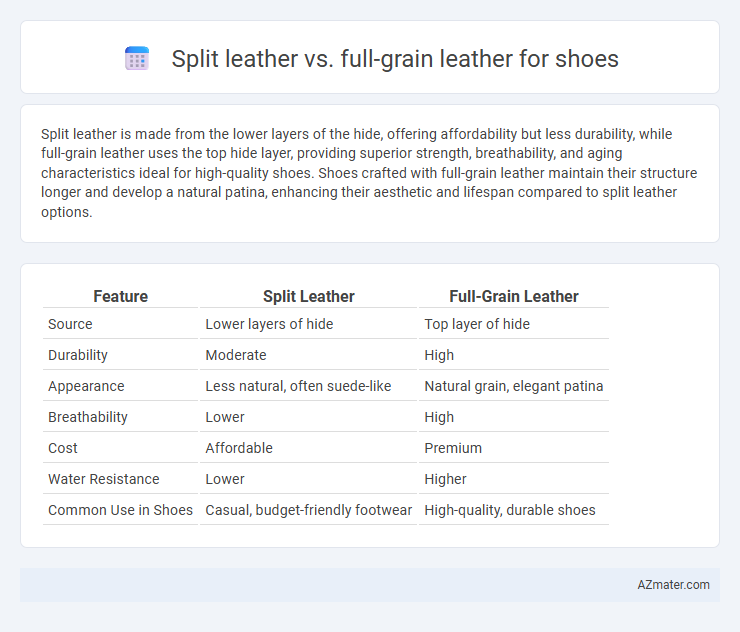Split leather is made from the lower layers of the hide, offering affordability but less durability, while full-grain leather uses the top hide layer, providing superior strength, breathability, and aging characteristics ideal for high-quality shoes. Shoes crafted with full-grain leather maintain their structure longer and develop a natural patina, enhancing their aesthetic and lifespan compared to split leather options.
Table of Comparison
| Feature | Split Leather | Full-Grain Leather |
|---|---|---|
| Source | Lower layers of hide | Top layer of hide |
| Durability | Moderate | High |
| Appearance | Less natural, often suede-like | Natural grain, elegant patina |
| Breathability | Lower | High |
| Cost | Affordable | Premium |
| Water Resistance | Lower | Higher |
| Common Use in Shoes | Casual, budget-friendly footwear | High-quality, durable shoes |
Introduction to Split Leather and Full-Grain Leather
Split leather, derived from the lower layers of a hide, offers a more affordable and flexible option for shoes but lacks the durability and natural grain found in premium leather types. Full-grain leather, retaining the hide's outer layer with its original texture and pores, provides superior strength, breathability, and develops a rich patina over time. Shoe manufacturers often prefer full-grain leather for its longevity and aesthetic appeal, while split leather is commonly used in budget-friendly footwear and components like suede.
Key Differences Between Split Leather and Full-Grain Leather
Full-grain leather is made from the top layer of the hide, retaining natural grain and providing superior durability and breathability, making it ideal for high-quality shoes. Split leather is derived from the lower layers of the hide, often coated or embossed to mimic the grain, which results in lower durability and less natural appearance. The key differences lie in texture, strength, and aging process, where full-grain leather develops a rich patina over time, unlike split leather that tends to wear out faster.
How Split Leather Is Made
Split leather is created by splitting a hide into layers after the top grain is removed, leaving the fibrous lower layers. This process yields a material with less natural durability and breathability compared to full-grain leather, which retains the entire epidermis. Split leather is often coated or embossed to enhance appearance and water resistance for shoe manufacturing.
How Full-Grain Leather Is Made
Full-grain leather is crafted from the top layer of the hide, retaining the natural grain and imperfections that enhance durability and breathability in shoes. Unlike split leather, which comes from the lower layers and undergoes heavy processing, full-grain leather undergoes minimal sanding and buffing to preserve its strength and develop a unique patina over time. This preservation of the hide's outermost layer makes full-grain leather an ideal choice for high-quality, long-lasting footwear.
Durability Comparison: Split Leather vs Full-Grain Leather
Full-grain leather offers superior durability compared to split leather due to its intact natural grain layer, providing greater strength and resistance to wear and tear. Split leather, derived from the lower layers of the hide, tends to be less durable and more prone to stretching and damage over time. Shoes crafted from full-grain leather often maintain structural integrity and aesthetic appeal longer than those made with split leather.
Appearance and Texture Differences
Full-grain leather exhibits a natural, uneven texture with visible grain patterns, providing a rich, luxurious appearance and developing a unique patina over time. Split leather has a more uniform, smooth surface often coated with a synthetic layer, resulting in a less breathable and less durable texture. The distinct grain visibility and tactile depth in full-grain leather make it a premium choice for shoes, while split leather offers a more affordable, consistent look with reduced natural character.
Breathability and Comfort in Footwear
Full-grain leather offers superior breathability and comfort for shoes due to its natural grain intact, allowing better air circulation and moisture absorption. Split leather, derived from the lower layers of the hide, tends to be less breathable and can feel stiffer and less comfortable over extended wear. Choosing full-grain leather enhances foot ventilation and reduces sweat buildup, improving overall comfort during prolonged use.
Cost and Value: Which Leather is More Affordable?
Split leather shoes are generally more affordable due to lower-grade leather layers sourced from the hide's underside, making them budget-friendly but less durable. Full-grain leather shoes, though pricier, offer superior strength, breathability, and longevity, translating to better long-term value. Choosing between split leather and full-grain leather depends on balancing upfront cost against durability and overall shoe lifespan.
Best Uses for Split Leather and Full-Grain Leather Shoes
Split leather is best suited for budget-friendly shoes such as casual sneakers, loafers, and fashion footwear where appearance and affordability are prioritized over durability. Full-grain leather is ideal for high-quality dress shoes, boots, and work shoes that require superior strength, breathability, and long-lasting wear. Shoes made from full-grain leather develop a rich patina over time, making them perfect for enthusiasts who value aging and character in their footwear.
How to Choose the Right Leather for Your Shoes
Choosing the right leather for your shoes depends on durability, appearance, and budget, with full-grain leather offering superior strength, natural texture, and longer lifespan compared to split leather, which is more affordable but less durable and often treated or coated to mimic full-grain. Full-grain leather develops a unique patina over time and provides better breathability, making it ideal for dress or high-quality casual shoes, while split leather suits fashion-forward, affordable options without heavy wear demands. Prioritize full-grain leather for investment shoes requiring longevity and resilience, and select split leather for economical styles with moderate wear expectations.

Infographic: Split leather vs Full-grain leather for Shoe
 azmater.com
azmater.com